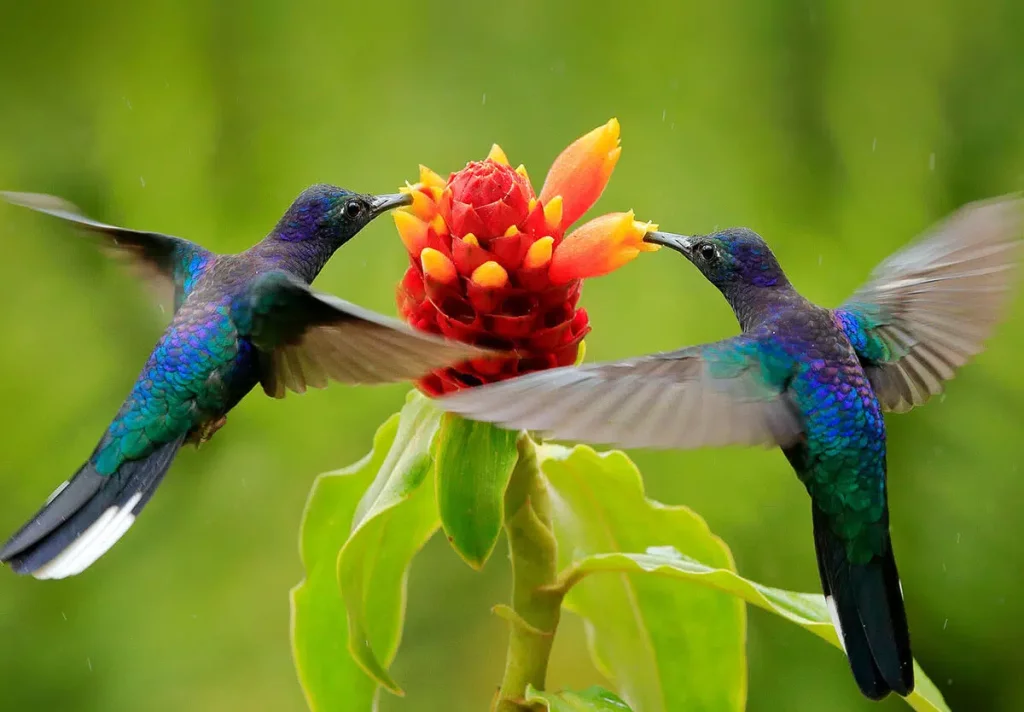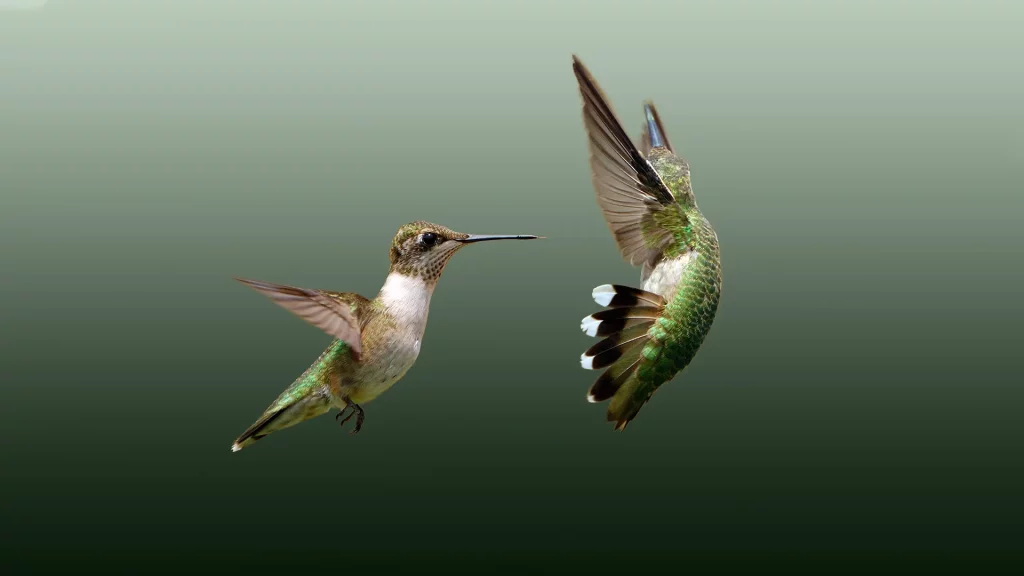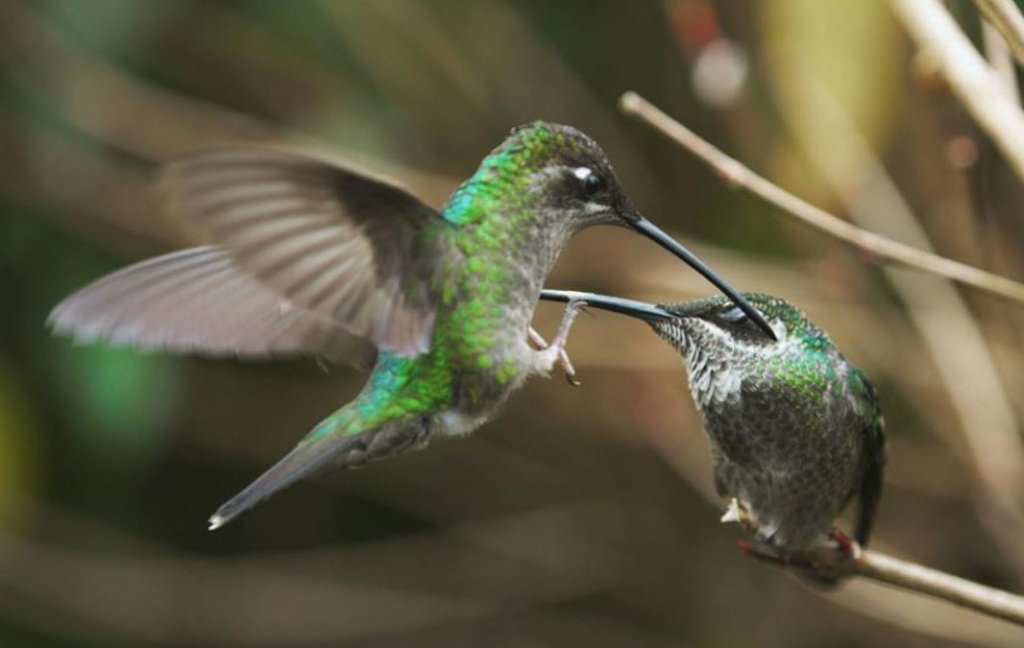Hummingbirds are all fun and cute until you realize that some of them are aggressive and bully other birds around them.
If you’re a feeder you would face several difficulties while feeding the bully hummingbird and the trouble gets doubled when they try to bully, you as well as other birds around them.
Yes, they may seem small and cute to our eyes, but hummingbirds are proven to get aggressive at times.
New visitors might find their bully behavior entertaining but the yard owner is aware of all the bullies they face while feeding other hummingbirds.
You will find one or more of these hummingbirds in a group but let us talk about a positive thing.
There are several ways that can calm down your bully hummingbirds, let us discuss some of them.
Why are Hummingbirds Aggressive?
Hummingbirds, known for their vivid colors and rapid wing movements, also display a lesser-known trait: aggression.
This behavior is most evident around hummingbird feeders. The primary reason for their aggressiveness is territoriality.
These tiny birds are fiercely protective of their feeding areas.
When another bird invades this space, the resident hummingbird views it as a threat to its vital food source.
This reaction is akin to how humans might respond to an intrusion in their personal space.
The feeder, to the hummingbird, represents a critical resource, essential for survival, especially during migration and breeding seasons.
Hence, they aggressively defend it from other birds. Understanding this natural behavior can help in managing feeders better and appreciating these remarkable birds’ survival instincts.
The Territorial Behaviour of Hummingbirds
Hummingbirds, with their numerous species, exhibit varying levels of territorial behavior.
Among these, the Rufous Hummingbird is particularly noted for its aggressiveness.
This territorial instinct is predominantly seen in male hummingbirds. They often engage in combative displays to defend their territory, a crucial aspect for their survival and mating success.
Interestingly, while males are the primary defenders of territory, it is the female hummingbirds that take on the task of building nests.
This territoriality extends to areas where they currently reside, including spaces provided by humans, such as gardens or feeders.
In these areas, hummingbirds may exhibit territorial behavior towards others of their species, guarding their space diligently.
This behavior underlines the complex social dynamics of hummingbirds and their instinctive drive to protect their habitat.
How to Recognize Territorial Aggression?

To better understand and address territorial aggression in hummingbirds, it’s important to recognize these key behaviors:
1. Aggressive Sound
Territorial hummingbirds often emit loud, fast chirping to signal ownership of their area.
This sound serves as a clear warning to other hummingbirds, asserting dominance over the feeding or nesting site.
Along with chirping, a distinct buzzing sound can also be heard, acting as an alert to fellow hummingbirds.
Recognizing these sounds is the first step in identifying and addressing territorial disputes among hummingbirds.
2. Body Language
Aggression in hummingbirds is also evident through distinct changes in body language.
To intimidate rivals, they may make themselves appear larger. For example, the Rufous Hummingbird, known for its bold behavior, displays its bright-colored gorget to deter others, while other species might spread their wings or puff up their feathers.
Understanding these visual cues is crucial in identifying a bully hummingbird and taking steps to reduce conflicts.
3. Fighting
Physical confrontation is a more extreme form of territorial aggression. Hummingbirds may engage in fights using their talons or beaks, leading to serious injuries or, in rare cases, death.
This behavior usually occurs when other deterrents have failed and signifies a high level of territorial aggression.
Recognizing when fights are about to ensue can be key to intervening and attempting to get rid of the bully hummingbird.
4. Chasing
One of the most common signs of territoriality is when a hummingbird chases another from its area.
This relentless pursuit is a clear indicator of a hummingbird asserting its dominance over a specific territory.
Observing and understanding these chasing behaviors can be vital in managing the presence of bully hummingbirds and ensuring a more harmonious environment for all birds in the area.
5. Dives
A particularly dramatic display of territorial aggression is the high-speed dive.
The aggressive hummingbird soars high above the intruder before diving down at high speed, often accompanied by sharp chirping sounds.
These dives are not only a display of dominance but also a warning to the intruder. Recognizing the preparatory signs of these dives can be instrumental in managing aggressive hummingbirds and maintaining a peaceful environment.
How to Stop Territorial Behaviour of Hummingbirds?

1. Increase the Number of Feeders
Adding more feeders in your garden can significantly reduce territorial aggression among hummingbirds.
By providing each bird with its own feeder, you reduce competition and conflict over resources.
This strategy not only ensures that each hummingbird has access to food but also helps in calming aggressive birds, as they feel less threatened by the presence of others.
It’s a simple yet effective way to create a more peaceful feeding environment for these vibrant birds.
2. Create Clusters Between Hummingbirds
Setting up feeders in clusters can surprisingly help in reducing aggression.
Initially, it might seem counterintuitive, as it could attract more birds and potential bullies.
Clustering feeders can create a communal feeding space, preventing any single hummingbird from dominating.
This approach encourages sharing and can significantly dilute the territorial behavior of aggressive hummingbirds, fostering a more harmonious environment.
3. Place feeders Where they Perch.
To minimize territorial disputes, observe where the aggressive hummingbirds usually perch and place feeders nearby.
This allows these birds to claim a feeder close to their favorite spots, reducing their need to patrol and defend a larger area.
Such a targeted approach not only confines their territorial behavior but also leaves other feeders free for the rest of the hummingbird population, promoting a more balanced and less hostile feeding atmosphere.
4. Inviting More Hummingbirds to Your Yard
By creating an inviting habitat with multiple feeders, you encourage a greater number of hummingbirds to visit your yard.
This increased diversity can lead to a more dynamic interaction among hummingbirds, diluting the impact of any one bully.
More birds in the environment mean the dominance of a single aggressive individual is lessened, leading to a more peaceful coexistence and a delightful birdwatching experience.
5. Curbing Hummingbird’s Aggression
While it is entertaining and fascinating to see a hummingbird showing his aggression, but it is obviously not for the other birds in your yard or other hummingbirds. It is so unfair for the visitor birds of your yard that get to feel all the bully because of one bully hummingbird.
There are very few to minimum ways to stop the bully hummingbirds, but the most effective ways are:
- Feeder Spacing
- Increased Number of Feeders
- Feeder Placement
- Perch Position
Finding & Eradicating the Root Cause of Hummingbird’s Aggression

Spotting the Root Cause
To address bullying or aggressive behavior in hummingbirds, it’s crucial to identify the root cause. Often, this aggression stems from territorial instincts.
Hummingbirds can become defensive and hostile when they perceive a threat to their feeding or nesting area.
This threat could be from other hummingbirds, different songbird species, or even predators like cats. Understanding the specific trigger for their aggression is key.
By eliminating or minimizing these stressors, you can help calm theaggressive hummingbird.
This may involve adjusting the placement of feeders, creating safer feeding zones, or ensuring that other animals do not intrude into their space.
Addressing these underlying issues is essential for restoring peace among your hummingbird visitors.
Getting Rid of the Root Cause
To mitigate the root causes of aggression in hummingbirds, focus on their territorial behavior and discomfort around other animals.
To discourage this aggression, consider creating a more isolated environment for them. Providing separate feeders for each bird can significantly reduce territorial disputes.
Additionally, arranging these feeders strategically throughout the yard allows each hummingbird to have its own space.
Adjusting the position of perches can also be beneficial, as it alters their established territories.
Increasing the overall number of feeders further ensures that each bird has ample access to food without feeling threatened by others.
These changes can create a more peaceful and harmonious environment for all the hummingbirds in your yard.
Final Words
Hummingbirds, with their tiny size and endearing qualities, often need our attention, especially when they exhibit aggressive or bullying behaviors.
Dealing with these behaviors requires specific measures to ensure a peaceful environment in your yard.
To start, frequent cleaning of your yard is essential, particularly when you increase the number of feeders.
More feeders can lead to a rise in bacteria and germs, potentially spoiling the nectar.
This approach can be a subtle yet effective way to get rid of the bully hummingbird by subtly demonstrating that the yard is a shared space, not owned by any single bird.
By implementing these strategies, you can enjoy the presence of calm, non-aggressive hummingbirds in your garden, making it a serene and joyful place for both you and these charming bird


I have a black headed with a red ring around the throat hunningbird that keeps all the other birds away from the feeder, I hate to see this. I put up another feeder, he runs everyone off from this one.
I have the same problem… I have a bully that chases off all the other hummingbirds , so I also got another feeder but the bully also claimed that one and also chases all the other off.. it’s frustrating huh? I thought about taking them down for about a month to rid of the bully but haven’t done that yet.. I’m at a loss can anyone help us?
I moved the Bush the bully would hide. I then took down the good feeder and put out another feeder of just plain water. It does lose all gunners but after a while I will put the good feeder back out. He no longer sits on the fence waiting. He has disappeared. So far so good.
Did it work?